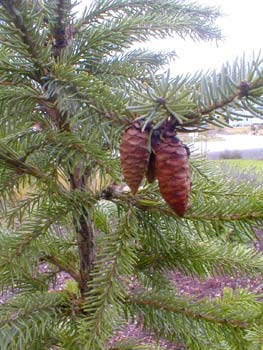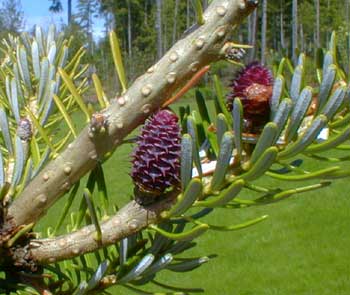
Sitka Spruce; aka,
Coast Spruce or
Tideland Spruce
"You can't be suspicious of a tree,
or accuse a bird or a squirrel of subversion
or challenge the ideology of a violet."
-Hal Borland
(1900-1978)
(1900-1978)
Sitka Spruce is also known as the Coast Spruce, Tideland Spruce, or Yellow Spruce, plus a couple names that never caught on much at all, Menzie's Spruce or Silver Spruce.
As one of the tallest trees in the world, & the world's largest spruce, Sitkas are commonly 125 feet tall but only three to five feet in diameter & thin-barked. But it has the potential of being much larger.
An old survivor that is often said to be the largest living Sitka Spruce can easily be reached right here in our state of Washington. Locals claim that it is a thousand years old though most experts are pretty sure Sitkas only live 700 or 800 years. This famous example is in the Rainforest Resort Village on Lake Quinault. It is 191 feet tall; in diamter, counting the buttresses at the base, it is 58 feet around.
There are competitors in park forests here & there & arguments about which is really biggest, & a less accessible Sitka Spruce in the Queets River Valley is bigger. But the Lake Quinalt tree is the biggest that tourists can easily visit.
It is a common giant along the Pacific Coast from Kodiak Island, Alaska, to the Queen Charlotte's & Vancouver Island & Olympic Penninsula. It is more thinly scattered in rainy zones or foggy inlets well into northern California, not quite so far as San Francisco.
 It is only spottily found more than fifty miles inland, though occasionally it appears further up rivers, such as in the lower elevations of the western side of the Cascade Mountains, or in the Federation Forest State Park along the White River east of Enumclaw, Washington, where several old-growth survivors can be seen.
It is only spottily found more than fifty miles inland, though occasionally it appears further up rivers, such as in the lower elevations of the western side of the Cascade Mountains, or in the Federation Forest State Park along the White River east of Enumclaw, Washington, where several old-growth survivors can be seen.Due to past harvesting, the Sitka spruce has become a rare tree in Puget Sound forests per se. By being so kind as to grow near the Sound, it was one of the first giants to be floated away to lumber mills. An exception would be the Sitkas growing in the West Hylebos Wetlands & wildlife refuge near Federal Way, one of the Sound's few unruined bog forests.
It grows in areas that are not only the heaviest rainfall regions of North America, but also among the stormiest. Sitka spruces, as well as the even more easily blown over Western Hemlock, have a fascinating adaptation to being blown down. Blow-downs become "nurse logs" & can be covered end to end with seedling spruces & hemlocks such as thrive in the decaying wood of fallen giants.
Their water requirements are high so they love best maritime tideland zones or rainforest conditions. On the opposite side of Olympic Penninsula from our home, in the glacial valleys of the Hoh & the Queets, are areas of prestine & ancient forests dominated by this Coast Spruce.
As a garden specimen, it would be suited only for a very large yard, & should not be attempted in areas with long dry summers, or it is apt to be attacked by spruce weevils followed by slow decline. It might be a good choice, however, in waterfront locations where a large tree was needed close to the tides. Only a lodgepole pine or a Sitka spruce would be guaranteed to flourish in such salty air.
A major timber industry tree, light for its strength & notably flexible, it has been used for everything from guitar wood & pianos to wooden ships & the manufacture of Britain's Mosquito Bombers in World War II.
Howard Hughes famous airplane the Spruce Goose was made of Sitka Spruce. Its more mundane uses includes such things as crates, plywood, flooring, pallets, paneling & doors. Thanks to the efforts & recommendations of pioneer botanist David Douglas (1799-1834), it was introduced into England & northern Europe in production forests, where Sitka spruces, together with the Northwest's Douglas-fir, have reshaped the European timber industry.
The male cones or strobili are yellow-brown to red; they can be partially erect or entirely pendant, up to three & a half inches long. The female cones are smaller & green to purple aging to red-brown. The cones tend to occur only in the top of the trees near the ends of smaller branches.
Cones develop to maturity in a single year. Generally trees have to be quite mature, from fifteen to fourty years old, before they begin producing cones. But the cones photographed for this page were taken in a friend's garden; the tree was only seven feet tall.
Generally speaking they produce cones prematurely only if stressed, as though wishing to reproduce before they die. Long before I began landscaping in that particular garden, the estate's former owner brought in truckloads of chipped bark & loaded it onto the ground in some places a foot & a half deep. Which was crazy.
This not only kept down weeds as the lunatic hoped but it would but also killed some shrubs. One my tasks was to remove the excesses of bark, sometimes mixing in soil & fertilizer to hasten it's break-down into compost. I cleared away the bark heaped up around the trunk of the Sitka, & still have my doubts it'll survive, but it has a chance now.
Aboriginal tribes thought the Sitka spruce was magical. Its wood was carved into love-charms. During ceremonial dances, capes were made from boughs to protect the dancers from evil presences while the dancers portrayed powerful spirit-creatures.
The dried & split roots were used to weave water-tight hats & baskets as well as twine, fishing lines, & ropes. Scrapings from the inner bark was used as a laxative. The inner bark was also used as a fresh spice, or was pounded into cakes for storage, or mixed with berries, being rich in Vitamin C. The sap was used to treat skin irritations & sunburn; it was chewed for pleasure or for soar throat or toothache; & was used as caulking in waterproofing canoes.